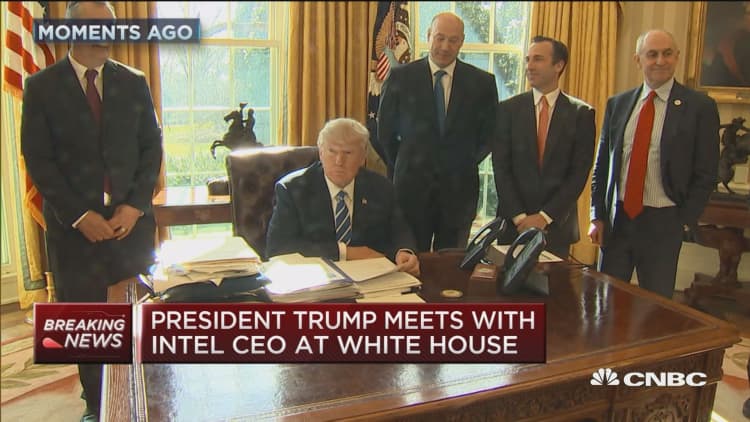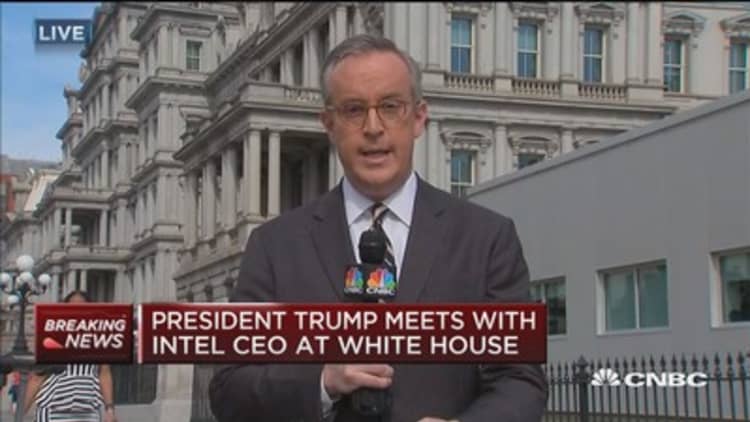
Intel announced a new investment in an Arizona factory on Wednesday — and it did so at the Oval Office, not its Santa Clara, Calif. headquarters.
The reason? To show support of the administration's "policies to level the global playing field," especially when it comes to taxes, CEO Brian Krzanich told employees in a company email.
"From a tax and regulatory position we have been disadvantaged relative to the rest of the world where we compete," the email said. "That's why we support the [a]dministration's policies to level the global playing field and make U.S. manufacturing competitive worldwide through new regulatory standards and investment policies."
The factory is not new — it has been in the works for several years, Krzanich said, and was even used by the Obama administration "as a symbol of the future of U.S. manufacturing," before falling vacant, The Arizona Republic reported.
Here's what President Barack Obama said at Intel's construction site for the factory in 2012:
"We have a huge opportunity to create more high-tech manufacturing jobs in the United States, and bring some of these jobs back from overseas. But we're going to have to seize the moment. That starts with changing our tax system."
But the new $7 billion investment to finish the factory reflects support of new policies, Krzanich told reporters on Wednesday. It also reflects the pressure to make smaller, faster chips despite scientific challenges, a principle that "marches on" for the company's business, he said.
"We've held off doing this investment until now," Krzanich told reporters at the announcement. "It's really in support of the tax and regulatory policies that we see the administration pushing forward. That will really make it advantageous to do it in the U.S."
There will be no incentives from the federal government for the Intel project, the White House said.
"Brian called a few weeks ago and said, 'We want to do a big announcement,'" President Donald Trump said at the Wednesday announcement.

The factory will eventually employ about 3,000 and support about 10,000 jobs, Intel said. But when asked if Intel would bring back jobs from overseas, Krzanich replied, "This is about expansion — new jobs in the U.S."
Intel has drawn fire from both political sides for some of its actions.
It has been criticized in conservative publications such as Breitbart for laying off thousands of staffers, while simultaneously supporting legislation that would increase the number of foreign worker visas granted each year.
Krzanich was also reportedly planning a fundraiser for Trump during the campaign season —which he later canceled.
Neil Campling, senior vice-president and head of global TMT research at Northern Trust Securities, said there will be "massive" technical challenges for Intel to make the chip plant a reality.
"Now this announcement tonight is probably because of the semiconductor demand we have alluded to in great detail in recent weeks, more than it is about [Trump]," Campling wrote in a note. "In this industry, talk is cheap until the production ramps. It is safer/more logical to focus on the companies who follow through with clear strategic plans."
Still, Intel's email to employees said, "When we disagree, we don't walk away."
Here's the full email:
Today I was proud to represent Intel at the White House, where we announced that Intel is investing $7b illion to complete a manufacturing facility that will produce the most advanced computer chips in the world. Fab 42 will create about 3,000 full-time Intel jobs and more than 10,000 jobs in Arizona to run and support the factory.
Fab 42 is an investment in our own future and will help ensure that the United States remains the global leader in the semiconductor industry. The 7 nanometer (nm) chips that we're targeting for this factory — the smallest, most powerful and efficient ever — will power state-of-the-art computers, data centers, and other high-tech devices. They will enable amazing breakthroughs in artificial intelligence, automated driving, medical research and treatment, and the factories of the future.
I would like to take some time to answer some of the questions that are probably on your mind about this investment and the timing. The first question that may come to mind is "why now?" The answer is relatively simple. Intel's business continues to grow, and investment in capacity and R&D ensures that the pace of Moore's Law continues to march on, fueling technology innovations we love and depend on. Leading-edge technologies like 7 nm require an increasing amount of factory space per wafer. These two factors have driven Intel to a point where we must get to work and build out another factory for 7 nm capacity. These state-of-the-art
factories take a couple of years to build out capacity and begin the start-up process. As a result, we made the decision to start the process now. We are excited to begin this journey to build the world's most advanced and complex factory producing Intel's 7 nm technology.
The second question is why did we choose to do this announcement at the White House? Intel is proud of the fact that the majority of our wafer manufacturing and R&D is based in the United States. This is due to the great infrastructure we have at our U.S. sites, our talented and highly skilled workforce and the proximity to our R&D facilities in Oregon. We've maintained this U.S.-based manufacturing even though approximately 80 percent of our product is sold outside the United States—we're one of the top 5 exporters and top 2 R&D spenders in the U.S.—and despite the fact that from a tax and regulatory position we have been disadvantaged relative to the rest of the world where we compete. That's why we support the Administration's policies to level the global playing field and make U.S. manufacturing competitive worldwide through new regulatory standards and investment policies.
Government policies play a critical role in enabling and sustaining American-driven innovation. At Intel we meet with governments from around the world, discussing and debating issues and policies important to our business, employees and shareholders. When we disagree, we don't walk away. We believe that we must be part of the conversation to voice our views on key issues such as immigration, H1B visas and other policies that are essential to innovation. We are an American innovation company that drives growth and opportunity in the United States and in
every corner of the world. I hope you join me in being proud that Intel, the largest and most advanced semiconductor company in the world, continues to invest and invent to push the boundaries of technology.
I also hope you will join me and several members of my team for an employee open forum and webcast on Thursday. We look forward to discussing this announcement with you in more detail and answering your questions.
Others predict the future. At Intel, we build it. Today's announcement is the latest exciting chapter in our almost 50-year story of innovation that is changing the world.
Brian
— CNBC's Jacob Pramuk and Arjun Kharpal contributed to this report.


